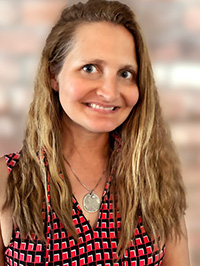How can educators identify and address potential barriers when designing instruction?
Page 8: Designing with UDL
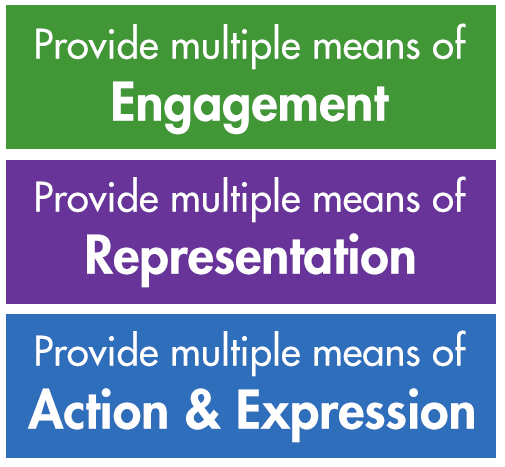 As you have learned, the three UDL principles—design multiple means of engagement, design multiple means of representation, and design multiple means of action and expression—are critical to developing accessible and equitable learning experiences. Educators who embrace UDL expect their students to differ in how they engage with learning, make meaning of content, and navigate and communicate their learning. With this learner variability in mind, educators build in flexible options, which reduce the barriers in the design of instruction and build learner agency.
As you have learned, the three UDL principles—design multiple means of engagement, design multiple means of representation, and design multiple means of action and expression—are critical to developing accessible and equitable learning experiences. Educators who embrace UDL expect their students to differ in how they engage with learning, make meaning of content, and navigate and communicate their learning. With this learner variability in mind, educators build in flexible options, which reduce the barriers in the design of instruction and build learner agency.
Research Shows
Although UDL itself is a multifaceted framework, a recent meta-analysis of 20 studies examined the effect of instruction utilizing UDL principles on learners’ achievement. The results demonstrated the emergence of UDL-based instruction as a research-based practice. More specifically, the academic achievement of learners in UDL-based settings was better than those in non-UDL-based settings. Furthermore, this positive effect was seen:
- Among learners with and without disabilities
- Across age groups
- In all subject areas
(King-Sears et al., 2023)
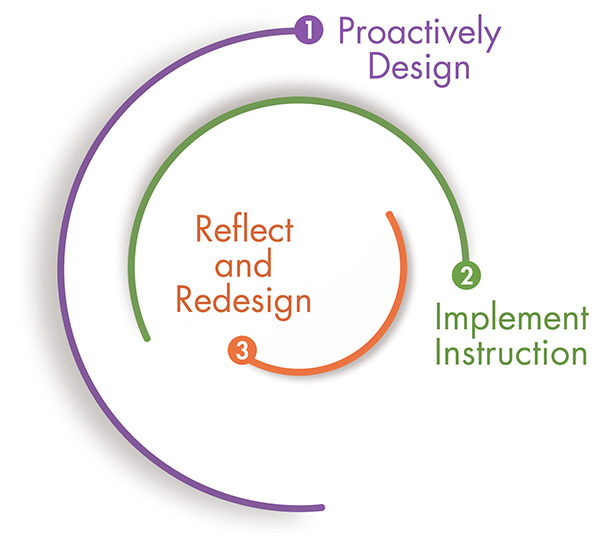
Educators can apply the UDL framework throughout the instructional cycle as they:
- Proactively design—before instruction
- Implement—during instruction
- Reflect and redesign—after instruction
Proactively Design
When educators think about UDL from the start, they design instruction to meet the needs of the widest possible range of learners. This proactive approach is time and resource efficient because educators are less likely to need to make modifications or reteach learners who were not able to access the original, less flexible lesson design. During this stage, educators should:
- Anticipate learner variability: Educators integrate options for engagement, representation, and action and expression when they expect their learners to have varied backgrounds, experiences, strengths, and challenges.
- Remove barriers: Educators identify where students might get “stuck” in the lesson. These anticipated barriers in the instructional design provide clues for where flexible options should be built in.
- Analyze the goal: Educators remember the mantra “clear goals, multiple means” and make sure that the learning goal is focused on what students will learn, not how they will learn it.
- Align the design: Educators develop assessments, plan instructional methods, and choose instructional materials that align with the learning goal, while encouraging different, yet robust, learning pathways for all learners to meet the goal.
Keep in Mind
UDL offers general and special educators a common language for designing learning experiences. When these educators collaborate and use UDL, they should remember:
- Even the most flexible designs do not eliminate the need for special education services and supports for students with disabilities—For example, an educator provides all students with options to demonstrate their understanding of a butterfly’s life cycle (e.g., drawing a diagram, composing a description), but a student with a physical disability may still require, and is entitled to, the AT outlined in the IEP (e.g., composition tools) to be able to engage in the learning experience.
- A necessary support for students with disabilities can be a beneficial option for all students—For example, a student’s IEP may mandate the use of audiobooks in place of textbooks. While this option is required for this student, it may also be beneficial for other students (e.g., those who struggle with reading, those who prefer to listen rather than read).
The following resources offer more information about using a UDL lens to design learning experiences.
Implement Instruction
During instruction, students and educators engage in the learning process together. During this stage, educators should:
- Communicate the goal: Educators ensure students know what they are working to achieve and remind them of the goal throughout the learning process.
- Facilitate learning experiences: Educators design the multiple means of engagement, representation, and action and expression that were planned during the instructional design stage.
- Empower expert learners: Educators provide opportunities for students to take charge of some of their own learning decisions. Educators observe how students use or don’t use available options and guide students in reflecting on how their choices benefit or pose barriers to their learning.
Reflect and Redesign
Try as they might, educators are rarely able to anticipate every barrier that might show up during instruction. After the learning experience, reflective educators evaluate what worked and what could be improved in the future. During this stage, educators should:
- Reflect on the goal: Educators begin by reflecting on the clarity of the learning goal. If it was unclear what students needed to know or be able to do, or if the means were inadvertently embedded within the goal, the educator should rewrite the goal for the next time the lesson is taught.
- Evaluate the assessments, methods, and materials: Educators carefully review the options that were provided during instruction and consider which were effective and which may have presented unexpected barriers.
- Seek student feedback: Invite students to reflect on their progress, what was helpful for their learning, and where they encountered challenges or barriers in the learning experience. This feedback can inform the educator’s future practice and also helps to build students’ learner agency.
- Plan for improvements: Educators identify adaptations that could strengthen the design next time. If the learning experience was appropriately accessible and flexible, educators can think about adjustments to the design that could further empower students as agents of their own learning.
UDL is a broad framework that can require a major shift in thinking for many educators. Likewise, designing instruction using UDL takes time and effort, but it is a worthwhile endeavor. Fully integrating the principles of UDL is an ongoing process that will not happen overnight. Educators can start by making small changes aligned with the UDL principles and build over time. As they do so, they will begin to see that all students have access to learning experiences and opportunities to use and grow their agency as learners.
To make designing instruction with UDL feasible, both Shauntā Singer and Sarah Wisecarver suggest starting with the goal, ensuring that it incorporates flexible means.
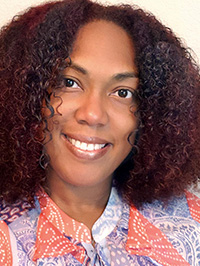
Shauntā Singer, PhD
Research & Development/
Professional Learning Research Scientist
CAST
(time: 2:00)
Transcript: Shauntā Singer, PhD
Anytime you have a set of guidelines, it can be very overwhelming. And so one recommendation I would have is to take one thing at a time. So first and foremost, there’s no requirement that says you have to do everything UDL, you have to follow all the checkpoints, all the Guidelines, all at the same time, and all in every lesson. And so, as a practicing teacher but also as a person who helps practicing teachers, I often will say, “What is one element of the Guidelines that you’d like to focus on for this lesson or for this unit or for this topic?” I may say, “Perhaps we’re going to focus on a goal that is written in such a way that all of your students can actually attain it. And so for this semester, for this six weeks, for this unit, we’re going to make sure that all the learning goals that we have are flexible enough so that all students are able to meet that goal.” So what might that look like? Instead of saying students will write a certain way, we may say students will demonstrate their understanding through a variety of methods. And so now we’ve made that more flexible. And so the expectation becomes that from here on out, every learning goal I create is going to be written as such that it’s flexible, it’s open, and more individual students are able to meet that goal. But one thing at a time, one chunk at a time. We are intentional. We are focused about making sure that all students are included, have access. And that is through our goals, it’s through our methods, it’s through our material, and it’s through our learning and physical environments. And so just one thing at a time. And as we become familiar, as we become more acclimated, and we receive feedback from our students, we receive feedback from our practice, then we can go on to that next thing. So it doesn’t feel like it’s an insurmountable task, but it’s just one chunk at a time.
Transcript: Sarah Wisecarver
So when I think about what someone new to UDL should do, one of the things I think about right away is to have them focus on the goal and to make sure that the goal of the lesson has a flexible means. Saying, “Students will read a nonfiction article and write about the main idea”—that’s not a very flexible goal because I’m asking them to read it, and I’m asking them to write about it. And there may be barriers in those two things for certain students. So changing the goal, we could think about just saying, “Students will determine the main idea of nonfiction.” So “determine” is a more flexible goal. Then they could listen to it through auditory. Maybe I provide a graphic organizer for some vocab work, so they could get some background knowledge right away. Maybe when they are talking about the main idea, they talk about it with a partner first or with me. Maybe they sketch it. Or, oftentimes in my classroom, I use an iPad, and there’s a spot where students could record their ideas. So maybe they go over to that quiet spot, and they hit record, and they just do a quick speaking of what they believe the main idea is. Or maybe they grab their Chromebook, and they create a Google Doc with speech-to-text. The goal of determining the main idea of nonfiction stays the same, but how the students achieve it, there’s multiple options. And I am providing feedback along the way, so when you look in the classroom, they’re almost never doing the same thing. They’re always doing different things based on what they need at the time, and I am constantly going from one group to another, to an individual, to check in to provide some meaningful feedback on that work. So when we can focus on a goal and make the goal flexible, I think that’s a really good way to start.
But it is important to realize the mantra, “Go slow to go fast.” We don’t want to go too quickly because sometimes when you implement new designs in education, and you don’t deal with fidelity, and you lose it. It’s a lot of work, don’t get me wrong, but it’s really great, fulfilling work, and we see such a difference with our students. They’re advocating for themselves. They know what they need for their learning.
To learn more about designing with UDL, we encourage you to listen to the extended IRIS Interviews below. First, Sarah Wisecarver describes a lesson in which she applied the UDL framework and discusses how her students engaged in the learning experience. Then, Jenna Gravel, Senior Research Scientist at CAST, and Nicole Tucker-Smith, Founder and CEO of Lessoncast, explain how the UDL framework is ever evolving to address barriers and to create a more equitable classroom for all students. They also offer advice for educators who are just starting to implement UDL.
- Universal Design for Learning (UDL): A Teacher’s Implementation
- Universal Design for Learning (UDL): Creating an Equitable Classroom
Returning to the Challenge
Mr. Hughes, Ms. Tong, and Mrs. Rios have deepened their understanding of the UDL framework. As they have applied the lens of UDL to each of their instructional components, they have anticipated learner variability and identified barriers in their original designs. All three educators have now proactively designed learning experiences to provide multiple means of engagement, representation, and action and expression. Below, explore some of the ways each educator’s learning experiences have changed after they applied UDL.

Mr. Hughes
Elementary mathematics lesson goal:
Students will represent numerical data on a bar graph and use the graph to answer questions.
| Designed Without UDL | Designed With UDL |
|
The means were embedded in the goal (i.e., color in a bar graph and answer questions on a worksheet). |
The goal allows for multiple means. |
|
All students were expected to engage with the same predetermined sources of data. |
Students are invited to choose relevant and authentic data to collect and analyze. |
|
Group work was assigned but lacked structure and clear expectations. |
Group work expectations are taught, and groups are structured with roles and responsibilities. |
|
All students were expected to use the same tools and materials (i.e., graph paper). |
Students are given options of tools and materials (e.g., graph paper, large chart paper, digital graphing tools). |
|
Content and skills were taught in isolation. |
Students have opportunities to transfer content and skills to new situations. |
|
All students were assessed using the same worksheet. |
Students are assessed through creation of varied authentic products. |
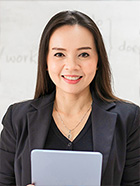
Ms. Tong
Middle school language arts unit goal:
Students will be able to identify a theme in a grade-level piece of fiction and locate supporting details in the text.
| Designed Without UDL | Designed With UDL |
|
The means were embedded in the goal (i.e., write an essay about the theme of a book). |
The goal allows for multiple means. |
|
All students used a single, fixed format of the text (i.e., paperback book). |
Students have access to multiple formats of the text (e.g., paperback book, e-book, audiobook). |
|
Ms. Tong assumed that all students understood the vocabulary in the text. |
Key vocabulary words are pre-taught and defined in a glossary. |
|
All students were expected to express their ideas in written format (i.e., shared document). |
Students are encouraged to use alternative formats (e.g., graphic organizers, images, audio) to express their ideas. |
|
All discussion occurred simultaneously with the whole class. |
Students engage in discussion in flexible small-group and paired activities. |
|
Ms. Tong monitored and evaluated student participation throughout the lesson. |
Students regularly assess their own engagement and progress. |
|
All students were assessed via a five-paragraph essay. |
Students select from multiple options for their final assessment format (e.g., essay, presentation, podcast). |
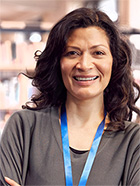
Mrs. Rios
High school biology lesson goal:
Students will be able to model and explain the process of mitosis.
| Designed Without UDL | Designed With UDL |
|
The goal was a list of task directions (i.e., read about mitosis, take notes, and take an exam). |
The goal describes what students will be able to do by the end of the lesson. |
|
Mrs. Rios assumed all students possessed adequate background knowledge about the content. |
Students complete an advance organizer to activate prior knowledge and anchor instruction. |
|
All students were expected to learn from the same representation of content (i.e., lecture, textbook). |
After a mini-lecture and discussion, students explore varied representations of content (e.g., images, videos, websites, textbook). |
|
Lecture slides included lengthy text with many details. |
Lecture slides use graphics and bullet points to highlight the big ideas. |
|
All students were expected to take notes in the same physical format. |
Students are given options of multiple note-taking formats and strategies. |
|
Mrs. Rios directed all learning activities and monitored students’ completion of work. |
Students make choices throughout the lesson and monitor their own progress. |
|
All students were assessed via a multiple-choice exam. |
Students select from a menu of final product options to demonstrate their learning. |

